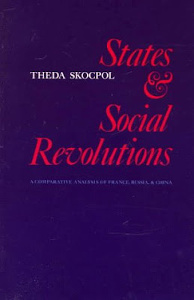States and Social Revolutions
 |
|
| Author | Theda Skocpol |
|---|---|
| Published | 1979 |
| Pages | 407 pp. |
| ISBN | |
| OCLC | 432787244 |
States and Social Revolutions: A Comparative Analysis of France, Russia and China is a 1979 book by political scientist and sociologist Theda Skocpol, published by Cambridge University Press and explaining the causes of revolutions through the structural functionalism sociological paradigm comparative historical analysis of the French Revolution of 1789 through the early 19th century, the Russian Revolution of 1917 through the 1930s and the Chinese Revolution of 1911 through the Cultural Revolution in the 1960s. Skocpol argues that these three cases, despite being spread over a century and a half, are similar in the sense that all three were Social Revolutions
Skocpol asserts that Social Revolutions are rapid and basic transformations of a society's state and class structures. This is different from, for example, a mere 'rebellion' which merely involves a revolt of subordinate classes but may not create structural change and from a Political Revolution that may change state structures but not social structures. Industrialization can transform social structure but not change the political structure. What is unique about Social Revolutions, she says, is that basic changes in social structure and political structure occur in a mutually reinforcing fashion and these changes occur through intense sociopolitical conflict.
Before social revolutions can occur, she says, the administrative and military power of a state has to break down. Thus pre-revolutionary France, Russia and China had well-established states that stood astride large agrarian economies in which the imperial state and the landed upper classes partnered in the control and exploitation of the peasantry but monarchy in each country faced an extraordinary dilemma in dealing with foreign power intrusion on the one hand and resistance to raising resources by politically powerful dominant domestic classes on the other. A revolution such as the French revolution also presented itself with a significant factor of power conducted with social, political, and economical conflicts. She describes the processes by which the centralized administrative and military machinery disintegrated in these countries, which made class relations vulnerable to assaults from below.
...
Wikipedia
